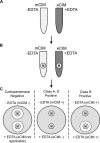EDTA-Modified Carbapenem Inactivation Method: a Phenotypic Method for Detecting Metallo-β-Lactamase-Producing Enterobacteriaceae
- PMID: 30867235
- PMCID: PMC6498035
- DOI: 10.1128/JCM.01757-18
EDTA-Modified Carbapenem Inactivation Method: a Phenotypic Method for Detecting Metallo-β-Lactamase-Producing Enterobacteriaceae
Abstract
The increase in the prevalence and impact of infections caused by carbapenemase-producing Enterobacteriaceae is a global health concern. Therefore, rapid and accurate methods to detect these organisms in any clinical microbiology laboratory, including those in resource-limited settings, are essential to prevent and contain their spread. It is also important to differentiate between serine- and metal-dependent carbapenemases elaborated by carbapenemase-producing isolates for epidemiologic, infection control and prevention, and therapeutic purposes. Here, we describe the development and evaluation of the EDTA-modified carbapenem inactivation method (eCIM), an assay for discriminating between serine- and metal-dependent (i.e., metallo-β-lactamases [MBLs]) carbapenemases when used in conjunction with the modified carbapenem inactivation method (mCIM). The eCIM had an overall sensitivity and specificity of 100% and was adopted by the Clinical and Laboratory Standards Institute as a method to use in combination with the mCIM to identify MBL-producing Enterobacteriaceae.
Keywords: EDTA-modified carbapenem inactivation method; MBL; carbapenemase; carbapenemase-producing Enterobacteriaceae; eCIM; mCIM; metallo-β-lactamase; modified carbapenem inactivation method; phenotypic detection.
Copyright © 2019 American Society for Microbiology.
Figures



Similar articles
-
EDTA-modified carbapenem inactivation method (eCIM) for detecting IMP Metallo-β-lactamase-producing Pseudomonas aeruginosa: an assessment of increasing EDTA concentrations.BMC Microbiol. 2020 Jul 20;20(1):220. doi: 10.1186/s12866-020-01902-8. BMC Microbiol. 2020. PMID: 32690021 Free PMC article.
-
Evaluation of the EDTA-Modified Carbapenem Inactivation Method for Detecting Metallo-β-Lactamase-Producing Pseudomonas aeruginosa.J Clin Microbiol. 2020 May 26;58(6):e02015-19. doi: 10.1128/JCM.02015-19. Print 2020 May 26. J Clin Microbiol. 2020. PMID: 32238433 Free PMC article.
-
Combination of modified carbapenem inactivation method (mCIM) and EDTA-CIM (eCIM) for phenotypic detection of carbapenemase-producing Enterobacteriaceae.BMC Microbiol. 2020 Oct 17;20(1):315. doi: 10.1186/s12866-020-02010-3. BMC Microbiol. 2020. PMID: 33069233 Free PMC article.
-
Phenotypic Detection of Carbapenemase-Producing Organisms from Clinical Isolates.J Clin Microbiol. 2018 Oct 25;56(11):e01140-18. doi: 10.1128/JCM.01140-18. Print 2018 Nov. J Clin Microbiol. 2018. PMID: 30158194 Free PMC article. Review.
-
Inhibitor-based methods for the detection of KPC carbapenemase-producing Enterobacteriaceae in clinical practice by using boronic acid compounds.J Antimicrob Chemother. 2010 Jul;65(7):1319-21. doi: 10.1093/jac/dkq124. Epub 2010 Apr 15. J Antimicrob Chemother. 2010. PMID: 20395214 Review.
Cited by
-
A Longitudinal Nine-Year Study of the Molecular Epidemiology of Carbapenemase-Producing Enterobacterales Isolated From a Regional Hospital in Taiwan: Predominance of Carbapenemase KPC-2 and OXA-48.Front Microbiol. 2022 Mar 11;13:703113. doi: 10.3389/fmicb.2022.703113. eCollection 2022. Front Microbiol. 2022. PMID: 35359715 Free PMC article.
-
Evaluation of NG-Test Carba 5 for Rapid Phenotypic Detection and Differentiation of Five Common Carbapenemase Families: Results of a Multicenter Clinical Evaluation.J Clin Microbiol. 2020 Jun 24;58(7):e00344-20. doi: 10.1128/JCM.00344-20. Print 2020 Jun 24. J Clin Microbiol. 2020. PMID: 32376668 Free PMC article.
-
Development and Application of a Pragmatic Algorithm to Guide Definitive Carbapenemase Testing to Identify Carbapenemase-Producing Pseudomonas aeruginosa.Antibiotics (Basel). 2020 Oct 27;9(11):738. doi: 10.3390/antibiotics9110738. Antibiotics (Basel). 2020. PMID: 33120865 Free PMC article.
-
Blood-Modified Carbapenem Inactivation Method: a Phenotypic Method for Detecting Carbapenemase-Producing Enterobacteriaceae Directly from Positive Blood Culture Broths.J Clin Microbiol. 2020 Jan 28;58(2):e01377-19. doi: 10.1128/JCM.01377-19. Print 2020 Jan 28. J Clin Microbiol. 2020. PMID: 31748319 Free PMC article.
-
In vitro activity of imipenem/relebactam, meropenem/vaborbactam, ceftazidime/avibactam, cefepime/zidebactam and other novel antibiotics against imipenem-non-susceptible Gram-negative bacilli from Taiwan.J Antimicrob Chemother. 2021 Jul 15;76(8):2071-2078. doi: 10.1093/jac/dkab141. J Antimicrob Chemother. 2021. PMID: 33956969 Free PMC article.
References
Publication types
MeSH terms
Substances
LinkOut - more resources
Full Text Sources
Miscellaneous

